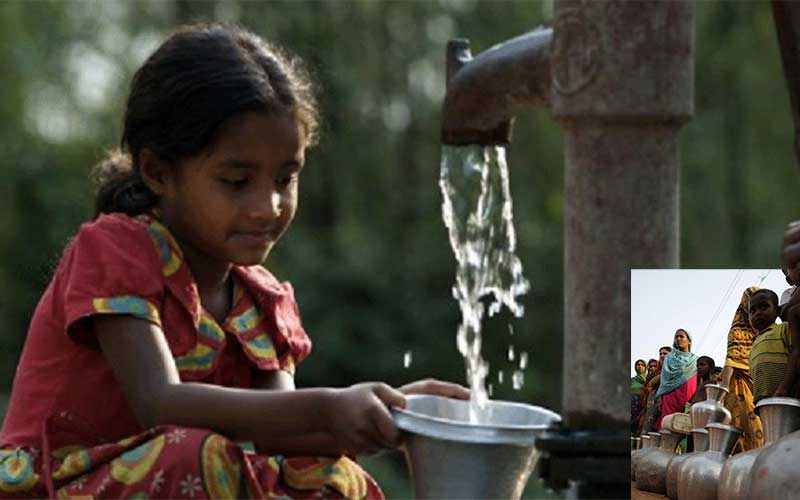Countries in crisis of clean water due to climate change
Although the word ‘climate’ is widely known, many have not been able to understand the meaning of the word. Everyone understands the matter, but is not able to explain it. There is a small calculation in the case of climate. Before giving the calculation, we know the elements of climate.
For example, wind, air pressure, temperature, humidity, cloud-rain, snowfall, volcanic eruptions, etc. are the elements of climate. Climate is the average weather of a specific area over 25-30 years (or 10-12 years).
We usually call climate change a ‘climate crisis’. Climate elements, like weather, are affected by factors such as latitude, elevation, forest coverage, land slope, mountain location, distance from the sea, ocean currents, wind direction, and soil characteristics.
This is what creates a climate crisis. As a result, the temperature of the earth is gradually increasing; which is called the ‘greenhouse’ reaction in scientific language. It is also known as global warming to the general public.
Our survival is closely related to the effects of climate. For example, the global warming of 2019 can be said. The increase in temperature that year compared to other years worried the world. There was also widespread temperature in the subcontinent in 2019.
Not only that, we have also come to know about the death of more than a hundred people in India in the same year. All this is only due to the effect of the climate crisis. It is worth noting that floods, droughts, storms, tidal waves, etc. are happening due to the effect of climate. The issue of river erosion is also related to the climate crisis.
The climate crisis is causing stronger cyclones in the Bay of Bengal, impacting the coast more severely. We have already seen the devastation of Super Cyclone-91, Sidr, Aila, Mora, Bulbul, Amphan and Yas cyclones.
We have seen the bodies of countless people, livestock and wildlife lying everywhere. Along with this, there is the issue of financial losses. Additionally, the rising land salinity in southern Bangladesh from tidal waves is a significant concern.
Disruptions in farming in southern Bangladesh have caused a major disaster in shrimp farming. Again, due to the increase in excessive salinity, the biodiversity and plants of the Sundarbans are being severely damaged. We are facing this terrible disaster for only one reason, and that is global warming.
The arbitrariness of industrialized countries is mainly responsible for global warming or the climate crisis. The least developed countries are now having to pay the price for the arbitrariness of those countries.
They are increasing carbon emissions while providing grants to countries impacted by the climate crisis. It is like pouring water on the ground.
The study has revealed that due to global warming, the Himalayan ice is also melting faster. Until 2000, the Himalayan ice melted at a rate of one percent. Currently, the Himalayan ice is melting at a rate of twice that! Hundreds of millions in Asia, including China, India, Bangladesh, Nepal, and Bhutan, will struggle with access to clean water.
This information was published in a 2019 report by ‘Science Advances’ during the climate conference in Bonn, Germany.
It is estimated that the total amount of water stored in the world is 1.386 billion cubic kilometers. Of this, 97.2 percent is salt water stored in the ocean, which is not drinkable at all. On the other hand, 2.15 percent of the water is frozen in the form of ice. That is also not drinkable.
Of the 0.65% of drinkable water, approximately 0.35% is underground and needs to be extracted for our daily drinking needs. This water is known to us as pure water. Every person needs this water at an average rate of three liters per day.
Apart from groundwater, the water from rivers, canals, lakes, or ponds and reservoirs is drinkable, but it is not pure. However, it is also an essential part of our daily life. This water is especially needed for bathing, cooking, and washing clothes. In total, an average person needs 45-50 liters of water per day.
Despite having three percent of the world’s total water, about 2 billion people in 80 countries face a shortage of clean water. In addition, about 1.8 million children in the world lose their lives every year just by drinking contaminated water. There are various reasons for the lack of pure water.
Among them, global warming, drought, falling groundwater levels and increasing arsenic levels have emerged as the main problems. If global warming increases by 1 degree Celsius, 1.45 billion people will face drinking water shortages.
Of these, 1.2 billion people in Asia and 250 million people in Africa will be affected. The people of Bangladesh will not be left out of this. On the contrary, Bangladesh will face a relatively greater water shortage. Moreover, its impact on the Asian region will be slightly greater than on other continents.
On top of that, a big alarming sign for us is that the rate of melting of the Himalayan ice has doubled. Where 50 centimeters of ice melted 25 years ago, the ice is melting at twice the rate today. Glacier researchers warn that if melting continues at this pace, 1 billion people in some Asian countries will face clean water shortages.
Researchers have also shown the way out of this disaster. They have clearly said that carbon emissions must be reduced to zero. This will prevent global warming.



